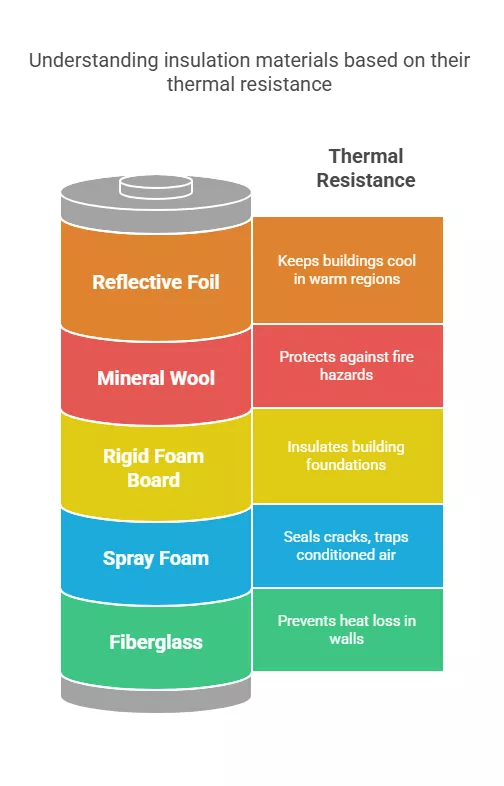Ranked #1 in Accurate and Reliable Estimation Services
A Fastest Turnaround 24 Hours!
Ranked #1 in Accurate and Reliable Estimation Services
A Fastest Turnaround 24 Hours!
Ranked #1 in Accurate and Reliable Estimation Services
A Fastest Turnaround 24 Hours!
Ranked #1 in Accurate and Reliable Estimation Services
A Fastest Turnaround 24 Hours!

In building construction, insulation and moisture control protection is extremely important. I know from my experience that thermal and moisture protective materials are essential in the construction of energy efficient, comfortable, and durable buildings. As a construction professional, estimating these materials to be accurate has proven to be integral in staying on schedule and within the budget.
This article will show you the major components of thermal and moisture protection, their estimating methods, and share other invaluable insights I gathered during my years on the field. I cannot wait to tell you about how effective moisture control and insulation makes such a massive difference in overall project outcome, as well as the energy efficiency of the structures.
If you are looking for accurate estimates to assist you with the budgeting calculations, then the thermal and moisture protection services will surely be a great asset for your overall project costs.
Based on what I know, thermal protection helps with controlling the flow of heat into or out of a building to help keep a comfortable indoor temperature, whether there is hot summer sunlight or cold winter weather. Moisture control, by…
These two systems – thermal protection and moisture protection – work together to make sure the building isn’t just weathered by the elements, but is also energy-efficient. From my knowledge, structures that do not have insulation work or moisture
barriers built tend to face high energy expenditure coupled with expensive maintenance work in the future.
There are several materials I’ve worked with over the years that are crucial for thermal protection. Here are the most common ones:
Fiberglass is extremely cost-effective and is widely used as a thermal insulator. From my experience, it works well within walls, ceilings, and attics. It is easy to put in and has a good R-value rating, which means it prevents heat loss or gain into the building. From my previous projects, it was the best choice for budget restrictive insulation.
Spray foam insulation has changed the game for many of the projects I have worked on. It serves the dual purpose of sealing cracks and gaps in addition to Thermal insulation. In places like the windows and doors where other types of insulation wouldn’t do as good of a job, I have used spray foam. It expands while being sprayed, forming a perfect seal which traps conditioned air inside.
I have worked with rigid foam board insulation (made of polystyrene or polyurethane) in areas requiring higher thermal resistance. It is particularly useful for external uses, such as insulating a building’s foundation. It is lightweight, easy to install, and very moisture resistant, which makes it a good choice for below-grade uses such as basement walls.
Mineral wool is a material I have previously utilized in other commercial projects. It provides excellent heat protection and is resistant to fire. I have used mineral wool in places where fire safety is critical, such as around electrical panels or in the walls separating garages from the living areas. Its ability to resist moisture also helps in areas that have high humidity.
Reflective foil insulation has proved to be useful in keeping buildings cool in warmer regions. For instance, I’ve put in in the attics to reduce heat gain from the sun. Although it is not the main insulation material, its effectiveness as a coolant jug in warm weather sweltering heat is undeniable.
From what I’ve seen, guarding against moisture is as crucial as guarding against temperature. If water enters the structure, it can result in serious problems such as mold, rot, and even damage the foundation. These are the materials I have used most for moisture protection:

Membranes waterproofing is critical for places encounter moisture and water. Personally, the bitumen membranes I’ve relied on for roofing and below-grade applications have been exceptional in mitigating water leakage. TPO (thermoplastic olefin) and EPDM (ethylene propylene diene monomer) have great functionalities. They are excellent for flat roofs as they are flexible, strong, and resist water damage.
Polyurethane coatings are often used in areas that need a flexible, durable, and seamless barrier against moisture. I’ve applied this type of coating to concrete floors and steel surfaces, and it’s proven to be an effective solution for preventing water damage in both new and renovated buildings.
Vapor barriers, like polyethylene sheeting, are essential for controlling moisture vapor. In my work, I’ve installed vapor barriers in basements and crawl spaces to stop moisture from seeping into walls and floors. It’s a simple yet effective way to prevent mold and mildew from forming.
Some insulation materials, like extruded polystyrene (XPS), are designed to resist moisture. I’ve used this material in areas like foundations where water is more likely to be an issue. It’s especially useful in places where water could potentially seep into walls or floors, and it offers excellent thermal protection as well.
Estimating the right amount of materials for thermal and moisture protection can be challenging, but it’s an important part of ensuring the project stays within budget. Here are some methods I’ve used over the years:
In the early days of my career, I did a lot of manual estimating. This involves going through blueprints and plans to figure out how much material you’ll need for thermal and moisture protection. It can be time-consuming, but it’s still a great method when working on smaller projects.
Nowadays, I rely heavily on estimating software. Tools like Procore and RSMeans help speed up the process and reduce errors. These software programs allow you to input project details and quickly calculate material quantities and costs. I’ve found this to be a real time-saver and a reliable way to ensure accurate estimates.
BIM is a more advanced approach that I’ve used in larger projects. It creates a 3D model of the building, which helps you visualize the thermal and moisture protection systems in place. With BIM, I can see how insulation and membranes interact with other building systems, and this makes estimating much more accurate.
Estimating for thermal and moisture protection also involves making sure the building complies with energy codes. I’ve worked on several projects where local codes dictated the type of insulation and moisture protection materials we could use. Energy codes like ASHRAE and LEED standards set specific requirements for materials, and estimating based on these guidelines is essential for a successful project.
Even with experience, estimating for thermal and moisture protection can be tricky. Here are some challenges I’ve faced:
One of the biggest challenges I’ve faced is dealing with fluctuating material costs. Prices for insulation and moisture protection materials can change based on market conditions, and this can impact the overall project budget. I’ve learned to stay up-to-date with pricing trends to ensure my estimates are as accurate as possible.
Buildings with unique designs can make estimating more complicated. For example, if a building has irregular shapes or different floor levels, it can be harder to calculate material quantities. I’ve had to adjust my estimates on projects like this to account for the complexity.
The climate where the building is located also plays a huge role in material selection and estimating. For example, projects in colder regions may require thicker insulation to meet energy codes, while buildings in hot climates may need more reflective materials. I’ve had to adjust my estimates depending on these environmental factors.
The protection of heat as well as moisture is critical to ensure that a building makes use of energy efficiently and has a long life. Personally selecting the right materials along with estimating them properly myself has impacted me greatly during the course of a project. If you wish assistance in estimating the materials that aid in the prevention of heat and moisture, Axis Estimation offers a complete thermal moisture protection service. We help you not exceed your financial expectations while streamlining the flow of your projects.
0 Comments